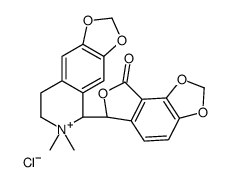38641-83-7
| Name | (6R)-6-[(5S)-6,6-dimethyl-7,8-dihydro-5H-[1,3]dioxolo[4,5-g]isoquinolin-6-ium-5-yl]-6H-furo[3,4-g][1,3]benzodioxol-8-one,chloride |
|---|---|
| Synonyms |
HMS3266A09
UNII-I3UNE1K4AF N-Me-bicuculline Bisculline methyl chloride |
| Description | Bicuculline ((+)-Bicuculline; d-Bicuculline) methochloride is a selective GABAA receptor antagonist with an IC50 value of 3 μM. Bicuculline methochloride induces clonic tonic convulsions in mammals and can also be used to block Ca2+ activated potassium channels. Bicuculline methochloride can be used in studies of epilepsy and other related psychiatric disorders[1][2]. |
|---|---|
| Related Catalog | |
| Target |
IC50: 3 μM (GABAA)[3] |
| In Vitro | Bicuculline 甲基氯化物 (1 μM和3 μM) 达到 GABA 的最大反应。Bicuculline 甲基氯化物似乎使 GABA的剂量-反应曲线向右平行移动,而不降低 GABA 的最大反应,这表明它在表达人 α1β2γ2L GABAA 受体的爪蟾卵母细胞中是一种竞争性拮抗剂[3]。 Bicuculline 甲基氯化物 (1-100 μM; 2 分钟; 应用于外部贴片) 有效地阻断了爪蟾卵母细胞中,对 Apamin (HY-P0256) 敏感的小导钙活化钾通道 (SK2) 电流和对 Apamin 不敏感的 SK1 电流[4]。 |
| In Vivo | Bicuculline 甲基氯化物 (1.25-3 mg/kg; 皮下注射) 能以剂量依赖的方式引起小鼠的阵挛性抽搐,这些抽搐会因注射 μ-阿片受体激动剂吗啡而加强[1]。 Bicuculline 甲基氯化物 (1.5-3.2 mg/kg; 皮下注射) 诱发小鼠全身性癫痫发作,对 clonus 的CD50 (惊厥剂量) 为 2.2 mg/kg,对 tonus 的 CD50为 2.4 mg/kg。 Bicuculline 甲基氯化物在3.2 mg/kg 的剂量下诱发的癫痫发作,可以通过 NMDA 拮抗剂 MK-801、CPP 和 CGS 19755 的预处理 (静脉注射) 来阻断[2]。 |
| References |
| Molecular Formula | C21H20ClNO6 |
|---|---|
| Molecular Weight | 417.84000 |
| Exact Mass | 417.09800 |
| PSA | 63.22000 |
| Personal Protective Equipment | Eyeshields;Gloves;type N95 (US);type P1 (EN143) respirator filter |
|---|---|
| Safety Phrases | 24/25 |
| RIDADR | UN 1544 6.1/PG 2 |
